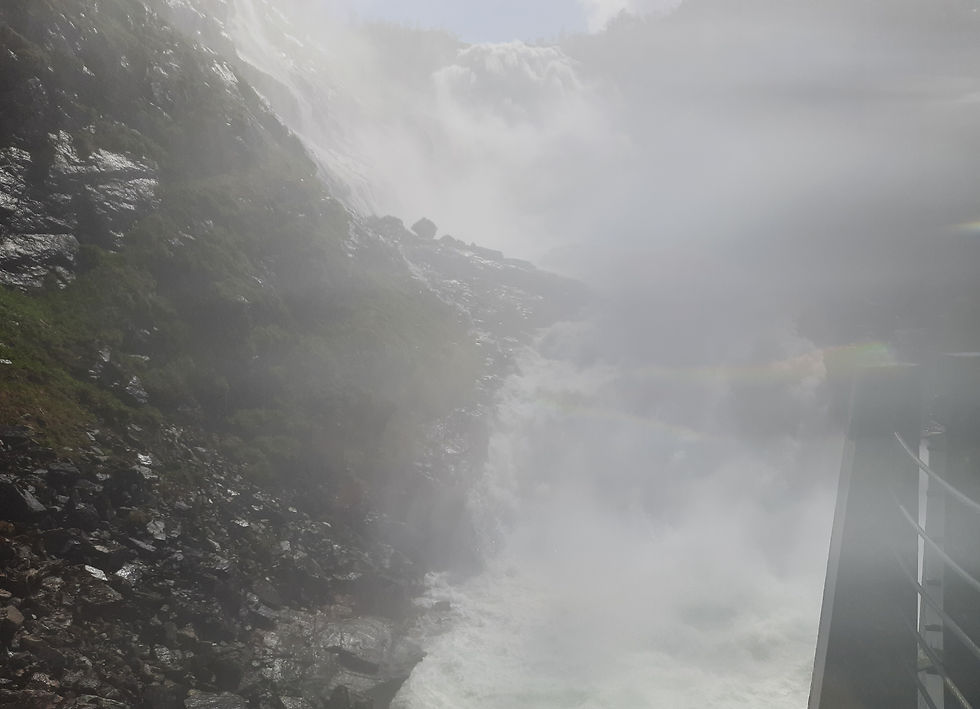Voyaging through the Fjords!
- Aditi Deshmukh
- Jun 8, 2024
- 3 min read

Fjords, a common site in Norway, are the most beautiful water bodies I have ever seen. It was hard for me to differentiate between a lake and a Fjord. A Fjord is a long, narrow valley with steep sides filled with seawater. They formed during the second ice age when vast glacier sheets drifted from the mountaintops toward the ocean, carrying soft rocks and mud. When the ice age ended, huge mountains as high as 8000 feet and valleys as deep as 4000 feet formed. Later, water from the rising sea level, melting snow from the mountains, and various other tectonic movements over millions of years filled these empty valleys with salty and fresh water. Norway has the highest number of Fjords, close to 1190 listed. We can see them in other parts of the world near the edge of continents. Fjords in plain English means - 'Where you travel across' - Sognefjord, near Bergen, is the longest (204 km) and deepest (3300 feet at one point) fjord.
I was fortunate to tour the most beautiful and wildest branch of Sognefjord, called Nærøyfjord, between Flåm and Gudvangan, which is 18 km long and very narrow in some places. The ultra-modern design electric boat starts from the beautiful Flåm village near Nærøyfjord and takes you straight into the fairy tale world of mountains and valleys with fjords and clear blue water. Standing on the deck, you could feel the fresh and cold air on your face, the soft sun above you, and the sound of the waterfalls meeting the fjords. The birds enjoying the free sky and free-floating clouds kept us company. I lost count of the waterfalls, forests, and charming villages in a span of two hours. I was hugely impressed by the eco-friendly tour and zero pollution on this most popular tour in Norway. I wondered about the scenic beauty of hundreds of other fjords in Norway not visited by tourists. No amount of words and photos can describe this natural beauty. It was the most mesmerizing and heavenly experience of the entire tour. I was reluctant to leave the boat on the other end at Gudvangan. Another charming village popular for tourists for boat and coach tours.
Norway has one of the best eco-friendly transports I have experienced from the cities to the remote mountains. There is always an option to choose from bus, train, boat, car, tramp, subway, or airplane that is eco-friendly, convenient, and costly. However, nothing can beat the experience of watching the spectacular scenery up and close through the comfort of your seat in a rail coach. Norwegian railways pass through the length and breadth of the country, some from one of the highest mountain peaks. There are thousands of tunnels, railways, and roads, many of which are built deep into the mountains.
Europe's most spectacular and steepest train journeys allured me to book the famous Flamsbana train ride. The Flamsbana train starts at Myrdal (pronounced as Meerdoll) at 867 meters above sea level and reaches Flåm (pronounced as Flome) at 2 meters above sea level. The train slowly crosses mountains, rivers, and waterfalls, giving you an old-world charm. It is a feat in engineering as it took 20 years of hard work to hand-cut around 20 tunnels in the deep mountains in the 1940s. At one point, our train made a 360-degree turn within the mountain without us realizing it.

The train makes a short, 5-minute stop at Kjosfossen waterfall, where the thundering water gushes at you before you even realize it. I grabbed the opportunity to witness nature's furry up and close. It was the closest I have ever been to a waterfall from a safe point. I glimpsed at the mountain, the waterfall, and the bright sun before getting drenched in gushing water. It was out of the world. I felt sorry for those who chose to sit inside looking at it from a distance. Sitting through the rest of the journey made me feel blessed to notice such wonders. I thanked all the tourists back in 1950 who had requested this short stop on Flamsbana. My voyage through these mountains, fjords, and waterfalls left me speechless by nature's creation and man's quest to make the most of it.

















Comments